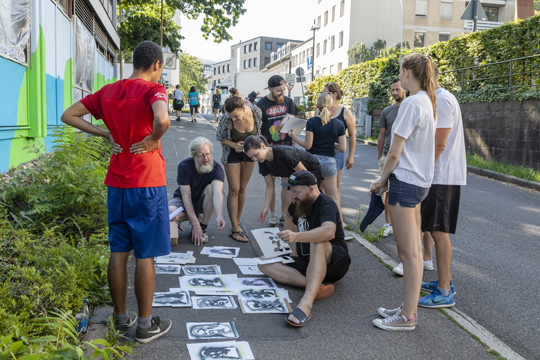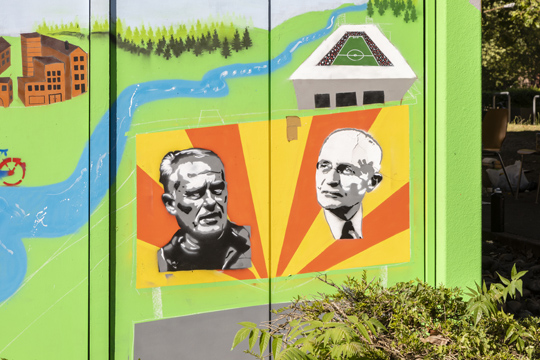“Draw, make a sketch!”
Freiburg, Jan 09, 2020
On Stefan-Meier-Straße, at the pedestrian underpass leading to Mathildenstraße, colorful graffiti greets passersby on their way through Freiburg. Among other things, the wall painting includes an octopus swimming through a polluted ocean, waving a pirate flag in one tentacle and a rainbow flag in another. Also depicted are a miniature view of Freiburg and a portrait of Christian Streich, head coach of the Bundesliga soccer club SC Freiburg, conversing with Walter Eucken, one of the fathers of social market economy. The question arises what a mural of this kind has to do with corporate culture and innovations. “A whole lot,” says Prof. Dr. Stephan Lengsfeld, whose students painted the wall. The management studies professor has been experimenting for many years with teaching methods that go beyond imparting mere book knowledge.
 Graffiti for business economics: With self-painted murals, students acquire skills that help them to initiate startup businesses. Photo: Ingeborg F. Lehmann
Graffiti for business economics: With self-painted murals, students acquire skills that help them to initiate startup businesses. Photo: Ingeborg F. Lehmann
“The haptic element is important, because it enables people to literally ‘grasp’ things,” explains Stephan Lengsfeld, professor of financing, controlling, and entrepreneurship. This idea forms the basis of EconRealPlay, a learning and teaching method Lengsfeld developed back in 2013. It enables students to experience economic procedures in hands-on simulations by means of Lego bricks and other materials and was the winner of the University of Freiburg’s Instructional Development Award in 2015. Lengsfeld incorporated his positive experiences from EconRealPlay into the entrepreneurship education module he has set up in the past three years. The module employs an active learning approach to equip students with the skills necessary for sparking off creative processes at companies and initiating startup businesses and innovations.
Keeping an Open Mindset
“The best business idea isn’t of any use if you only describe it,” says Lengsfeld. “You have to implement it, to take action on it.” In a classical lecture course, students learn relatively little about the competency for action. That’s different in a seminar where the students get together to create a mural. “There’s the concept of ‘mindset’ in psychology,” the economics professor says to explain his approach. “Mindset” refers to a person’s way of thinking, extending even to their general attitude toward life. A favorable attitude is one marked by a belief in individual possibilities for development and growth, a so-called growth mindset. People with an open mindset see more than those with a “closed” one. They’re more flexible and better at overcoming challenges – “all things that are useful for a successful entrepreneur or anyone who aims, in terms of intrapreneurship, to initiate new processes in an organization,” says Lengsfeld. “With a mindset like this, you also identify more business opportunities.”
The Role of Street Art
An open mindset is something that can be trained. One way to do so is through interdisciplinary exchange between the academic and the artistic – a confrontation that extends experiential spaces, pushes boundaries, and opens up new perspectives. Lengsfeld chose the public art form of street art to assume the role of this sparring partner in his seminar for personal reasons. “I like street art,” says the professor. “I always pay attention to the impression it leaves in the public space and how it affects me, even when I’m in other cities.” He did some research and finally contacted the artist Pone, a sprayer, for his seminar. In the first class meetings, Pone gave the students a little introduction to the history and technical aspects of graffiti and street art – including a field trip to the places in Freiburg where you can paint graffiti legally. One of these places is the pedestrian underpass next to the University of Music, the town’s oldest so-called “hall of fame.”
 More than knowledge from books: students and professor push their boundaries in the seminar. Photo: Ingeborg F. Lehmann
More than knowledge from books: students and professor push their boundaries in the seminar. Photo: Ingeborg F. Lehmann
Pushing Boundaries
Then the conceptual stage began. The students wanted to start by writing something, as they were used to doing, but Lengsfeld intervened: “Stop! No texts, please! Draw, make a sketch!” This isn’t equally easy for everyone, but that’s just the point, according to Lengsfeld: “You leave your comfort zone, discover new things about yourself. You push your boundaries. And that’s precisely what you need to do to come up with business ideas and innovations.” The teacher himself proved his flexibility in this process. “A seminar like this doesn’t necessarily need to follow the syllabus. I too need to be ready to make adjustments and should be able to react.” After the first class meetings, it became clear that a graffiti technique involving the use of stencils would be appropriate for realizing the ideas the students had come up with. Lengsfeld responded by calling in a second street artist who goes by the pseudonym TTF.
Finding Strengths and Bringing Them to Bear
That’s when things really got interesting. “The students come to understand that if they don’t take things into their own hands and get active now, there will be no end result. I’m not going to paint the wall for them,” says Lengsfeld and describes what happened next: “One or two people are perhaps good at organizing things. They get the materials, coordinate the course of events, provide the framework, so to speak. And others, those with more of a creative, artistic vein, start to fill this framework. Others discover their artistic vein.” In the most general terms, everyone asked themselves: “What strengths do I have, and how can I bring them to bear for the common goal?“ This has always worked great so far, says Lengsfeld: “I’ve never experienced in conducting such projects that a group doesn’t get active, that only a couple of people do all the work and the rest of the group remains passive.”
Parallels with Startups
The students learn a lot in this dynamic situation: about collaborative work in pursuit of a common goal, about the foundations for successful entrepreneurial culture and innovations. “It happened, for example, that one student had an idea for a subject. It was discussed in the group, developed further – and ultimately didn’t even make it onto the wall in its original form but provided the inspiration for further ideas that were then realized.” No cause for frustration, as Lengsfeld knows. “On the contrary, it can be very satisfying to know that your idea was the driving force in the process, as long as this achievement is acknowledged by the group.” This is exactly how things work in successful startup businesses: You have the idea for a good product, attempt to get it onto the market – and realize during the initial tests that customers actually need something different. Success here means being flexible enough to move away from your original idea.

Thoughts on the social market economy: Soccer coach Christian Streich and economist Walter Eucken were also pictured on the walls. Photo: Ingeborg F. Lehmann
An Interface with Developmental Psychology
But the seminar is about more than just learning the foundations of successful economic action. It also teaches students something about their own personality. “There’s an interface with developmental psychology there,” Lengsfeld confirms. “I’m also interested in personality development.” At the end of the course, the students thus all filled out an anonymous questionnaire asking them what they learned about themselves: What do I know now about myself, my behavior in a group, my strengths? One student then analyzed these results in his seminar paper.
Learning about Methods of Empirical Research
“We are ultimately researchers and also train students to do research,” stresses Lengsfeld. The students thus took action, while at the same time evaluating the processes involved and learning about methods of empirical research. For research purposes, the students also asked pedestrians what they thought of the mural as they passed by the wall on Stefan-Meier-Straße. In other words, they collected social impact measurements, both before and after finishing the mural. “After all, it’s a project in the public space,” says Lengsfeld, „and that’s something else I consider important: that we, as a university, go ‘outside,’ show people what we do, that we show more presence in society and engage people more in a dialogue. I think we were very successful in this respect, within a small scope, but successful all the same.” And it goes without saying that Lengsfeld didn’t made his students do all the work on their own: “I myself of course also created stencils and graffiti and painted them on the wall. Beforehand, I wouldn’t have thought myself capable of learning the technique. So the seminar helped me to push my boundaries as well.”
Mathias Heybrock

